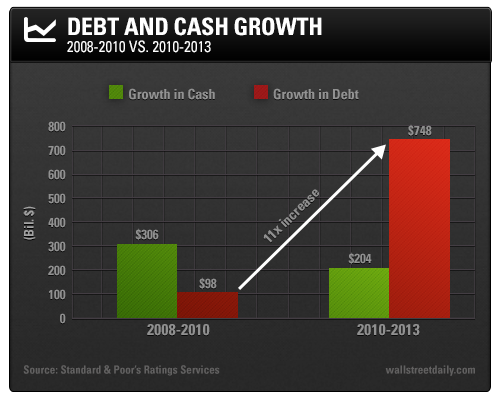S&P 500 companies are absolutely flush with cash right now.
Total cash has reached an all-time high, with non-financial firms holding an astounding $1.4 trillion, or 12% of assets.
For some permabulls, this is a clear sign to invest in the market. After all, current cash levels are much higher than at past market peaks, and companies flush with cash often return it to shareholders in the form of buybacks.
But before diving in headfirst, it’s worth finding out what’s beneath the surface. And in fact, a closer look reveals some troubling signs…
The Cash Conundrum
First, we have to consider how much cash is overseas.
That’s because a dollar of cash overseas is not actually a dollar of cash. Just consider that euros and yen held overseas aren’t worth nearly as much as they were just a few short weeks ago.
Plus, when a firm brings home overseas cash, it’ll face a tax hit of as much as 35%.
Meanwhile, the bigger problem is that cash in isolation means nothing. What’s truly important is cash relative to debt… and right now, net debt (debt minus cash) is at an all-time high for S&P 500 firms.
Just take a look at the chart below, and you’ll see that debt levels are actually rising much faster than total cash:

A report from Standard & Poor’s, published in April 2014, notes that for every $1 of cash growth from 2010 to 2013, debt grew by $3.67. That’s a complete reversal from 2008 to 2010, and the reason is likely the “robust credit market conditions offering access to cheap debt.”
Indeed, the low-interest-rate environment has encouraged companies to aggressively issue debt (ostensibly to finance buybacks or acquisitions), and firms have shown an incredible lack of restraint in this regard. In the first quarter of 2014 alone, corporations borrowed $993 billion.
Fast forward to today, and we find that U.S. non-financial corporations are carrying $9.6 trillion in debt… which makes the large cash cushion seem far less attractive.
Plus, cash is an unproductive asset. Would you want a ton of cash in this environment? Or would you rather have productive assets?
It makes you wonder why companies aren’t deploying more cash to build plants or refurbish equipment. Likely, they aren’t seeing the need to build up their business, as the demand for products and services isn’t robust. More broadly, it signals that companies have a generally bearish outlook on the economy.
In turn, the cash they’re holding is actually worse than unproductive – it’s losing value even with benign inflation.
Go With the Flow
Meanwhile, there’s another problem for income investors: While we like distributions in the form of buybacks, we really want huge free cash flow generation, which will allow firms to grow their dividends rapidly.
Yes, companies with a huge cash pile can buy back stock… but they might not have enough confidence in the underlying business to raise their dividends. And as we know, dividend growers outperform in the long run.
Therefore, we prefer solid businesses with strong free cash flows. Additionally, we can use EV/EBITDA, a metric that uses enterprise value (which excludes cash), to get a better picture of a firm’s valuation.
Bottom line: When deciding whether to invest, we should focus our attention on companies with strong free cash flows and a low EV/EBITDA. They don’t need to issue debt to buy back stock or increase their dividends, and they’re much more likely to continue increasing their dividends going forward.
Good investing,
BY Chris Worthington
